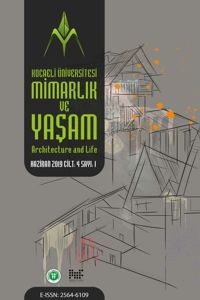Abstract
Mekân
tasarım yöntemleri gelişen teknoloji ürünleriyle birlikte çeşitlilik göstermeye
başlamıştır. Eskiden üç ve iki boyutlu el çizimi sunum yöntemleriyle kişide mekân
algısı oluşturulmaya çalışılırken, günümüz teknolojisiyle sonuç ürünü olan iç mimari ürünü sanal bir mekân olarak kişiye deneyimletmek
mümkündür. Bu deneyim mekân oluşumu için gerekli unsurların gerçeğe eş olarak seçilip,
sonucun gözler önüne serildiği iki boyutlu fotoğrafik çıktı ürünleriyle
sağlanabileceği gibi, çeşitli teknolojik unsurlar yardımıyla kişide mekân
ölçeğinde algı yaratacak biçimde ve üç boyutlu olarak
gerçekleştirilebilmektedir. İç mekân yaratım sürecinde gelinen bu noktanın
doğru olarak değerlendirilebilmesi için öncelikli olarak sonuç ürünüyle birey
arasındaki bağlantıyı sağlayan duyuyu iyi tanımlamak gerekmektedir. Bu yolla
sanal bir sonuç ürünü olarak iç mimari mekânın nasıl algılandığı ve nasıl daha
doğru algılanabileceği ortaya konularak geleceğe dair tavsiyelerde bulunulabilinecektir.
Bu çalışmada
konunun açıklanmasında öncelikle gözün görme işlevini nasıl gerçekleştirdiğine
değinilerek, göz ve sanal mekân ilişkisi açıklanmış, daha sonra iç mimari sonuç
ürünü olarak sanal mekanlar ele alınarak değerlendirmeler yapılmıştır.
Keywords
References
- Berger, John, Görme Biçimleri, 24.B., Metis Yayınları, İstanbul 2018, 7.Cevizci, Ahmet, Paradigma Felsefe Sözlüğü, 3.B., Paradigma Yayınları, İstanbul 1999, 583.Erarslan Özdağ, Sena, Mekan Tasarımında Kavramsal Tema (Konsept) Tasarımı, Kocaeli Üniversitesi Sosyal Bilimler Enstitüsü, Yüksek Lisans Tezi, Kocaeli 2018, 2.İlter, Tevfik, Mekan Tasarımında İç Mekan-Taşıyıcı Sistem Geometrisi Etkileşiminin Dini Yapılarda İrdelenmesi, Kocaeli Üniversitesi Sosyal Bilimler Enstitüsü, Yüksek Lisans Tezi, Kocaeli 2004, 34.Kayapa, Nihal, Gerçek ve Sanal Gerçeklik Ortamları Arasındaki Algısal Farklılıklarda Görselleştirmeye İlişkin Özelliklerin Araştırılması, Yıldız Teknik Üniversitesi Fen Bilimleri Enstitüsü, Doktora Tezi, İstanbul 2010, 38-39.Kuruüzümcü, Rıza, “Bir Dijital Ortam ve Sanat Formu Olarak Sanal Gerçeklik”, SanatDergisi, 2010, s.93-96
- M. Groh, Jennifer, Mekan Yaratmak, 2. B., Metis Yayınları, İstanbul 2017, 21-24, 46-51.Togay, Nuray, Mimarlık ve Sanallık, 1.B., Boyut Yayın Grubu, İstanbul 2002, 7.Pallasmaa, Juhani, Tenin Gözleri, 4. B., YEM Yayın, İstanbul 2018, 17.
Abstract
Space design methods have started to show diversity
with developing technology products. It is possible to experience the interior
design product which is the result product with today's technology as a virtual
space while three and two dimensional hand drawing presentation methods to
create a sense of space. This experience can be provided with
two-dimensional photographic output products in which the necessary elements
for space formation are selected as the real and the result is revealed, and it
can be realized in three dimensions with the help of various technological
elements in a way that creates perception in the space scale. In
order to be able to evaluate this point in the interior creation process
correctly, it is necessary to define the sound that provides the connection
between the result product and the individual. In
this way, it will be possible to make recommendations as to how the interior
architectural space is perceived as a virtual outcome product and how it can be
perceived more accurately. In this study, first of all, the relationship
between eye and space perception, the relationship between eye and virtual
space are explained. The eye performs and the visual function is researched.
Two and three dimensional virtual spaces and experienced virtual spaces are
examined with examples. This study is intended to serve as a written resource
for all researchers investigating the connection between technology and
interior architecture-space perception.
References
- Berger, John, Görme Biçimleri, 24.B., Metis Yayınları, İstanbul 2018, 7.Cevizci, Ahmet, Paradigma Felsefe Sözlüğü, 3.B., Paradigma Yayınları, İstanbul 1999, 583.Erarslan Özdağ, Sena, Mekan Tasarımında Kavramsal Tema (Konsept) Tasarımı, Kocaeli Üniversitesi Sosyal Bilimler Enstitüsü, Yüksek Lisans Tezi, Kocaeli 2018, 2.İlter, Tevfik, Mekan Tasarımında İç Mekan-Taşıyıcı Sistem Geometrisi Etkileşiminin Dini Yapılarda İrdelenmesi, Kocaeli Üniversitesi Sosyal Bilimler Enstitüsü, Yüksek Lisans Tezi, Kocaeli 2004, 34.Kayapa, Nihal, Gerçek ve Sanal Gerçeklik Ortamları Arasındaki Algısal Farklılıklarda Görselleştirmeye İlişkin Özelliklerin Araştırılması, Yıldız Teknik Üniversitesi Fen Bilimleri Enstitüsü, Doktora Tezi, İstanbul 2010, 38-39.Kuruüzümcü, Rıza, “Bir Dijital Ortam ve Sanat Formu Olarak Sanal Gerçeklik”, SanatDergisi, 2010, s.93-96
- M. Groh, Jennifer, Mekan Yaratmak, 2. B., Metis Yayınları, İstanbul 2017, 21-24, 46-51.Togay, Nuray, Mimarlık ve Sanallık, 1.B., Boyut Yayın Grubu, İstanbul 2002, 7.Pallasmaa, Juhani, Tenin Gözleri, 4. B., YEM Yayın, İstanbul 2018, 17.
Details
| Primary Language | Turkish |
|---|---|
| Subjects | Architecture |
| Journal Section | Makaleler |
| Authors | |
| Publication Date | June 30, 2019 |
| Published in Issue | Year 2019 Volume: 4 Issue: 1 |
Cited By
KURGUSAL MEKÂNLARDA RENK VE DUYGU İLİŞKİSİNİN RENK ŞEMALARI ÜZERİNDEN İRDELENMESİ: BEETLEJUICE FİLMİ
Anadolu Üniversitesi Sanat & Tasarım Dergisi
https://doi.org/10.20488/sanattasarim.1505970
Öğrenme Ortamı Olarak Üniversite Kütüphaneleri: Çankırı Karatekin Üniversitesi Kütüphanesi Fiziki Ortamına Yönelik Değerlendirme
Çankırı Karatekin Üniversitesi Sosyal Bilimler Enstitüsü Dergisi
https://doi.org/10.54558/jiss.1235709
Kütüphane Tasarımlarının Öğrencilerin Görsel Algıları Üzerindeki Etkileri: Ondokuz Mayıs Üniversitesi Tıp Fakültesi Örneği
Turk Kutuphaneciligi - Turkish Librarianship
https://doi.org/10.24146/tk.1222569
Digital Technology and Interior Architecture
Kocaeli Üniversitesi Mimarlık ve Yaşam Dergisi
Deniz DEMİRARSLAN
https://doi.org/10.26835/my.787081


